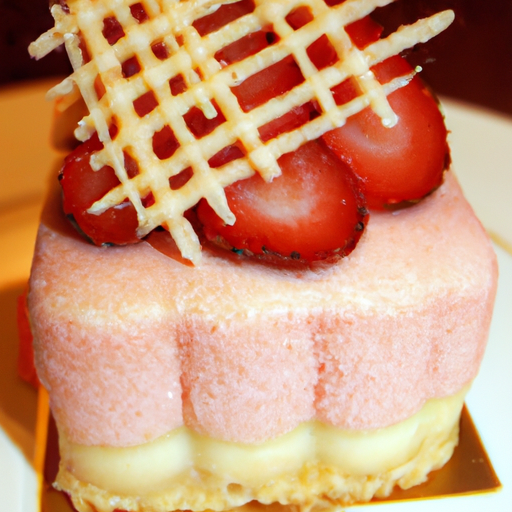Embark on a delectable journey through the tantalizing realm of French haute cuisine, from the legendary culinary mastermind Escoffier to the cutting-edge creations of modern gastronomy. Tastepan.com invites you to savor a rich tapestry of food culture and traditions, unravelling the fascinating stories behind regional cuisines and uncovering the intricate threads that connect them. Prepare to immerse yourself in the indelible heritage of French gastronomy, as we explore its evolution and enduring influence on the world of food. Let your taste buds wander and your appreciation for flavors deepen as we unravel the legacy of French haute cuisine.

The Evolution of French Haute Cuisine
Introduction to French Haute Cuisine
French haute cuisine is widely regarded as one of the most sophisticated and refined culinary traditions in the world. Rooted in centuries of culinary excellence, it is characterized by its meticulous preparation, elegant presentation, and emphasis on quality ingredients. This article will delve into the rich history of French haute cuisine, exploring its foundations, its evolution under the influence of Georges Auguste Escoffier, key characteristics of the traditional cuisine, as well as its modern adaptations.
The Influence of Georges Auguste Escoffier
Georges Auguste Escoffier, often referred to as the “king of chefs and chef of kings,” played a pivotal role in shaping and popularizing French haute cuisine as we know it today. Born in 1846, Escoffier revolutionized culinary practices and professional kitchens, introducing innovative techniques and organization systems that have stood the test of time. His impact on French haute cuisine is immeasurable, and his contributions continue to shape the way modern chefs approach cooking.
Key Characteristics of Traditional French Haute Cuisine
Traditional French haute cuisine is characterized by a combination of classic cooking techniques, precise execution, and an unwavering commitment to quality. Dishes are often elaborate and harmoniously blend flavors, textures, and colors. Presentation is of utmost importance, with careful attention paid to plating and garnishing. The cuisine places a strong emphasis on the use of fresh, seasonal ingredients, elevating them through expert preparation and skillful combinations of herbs and spices.
Foundations of French Haute Cuisine
Classical French Cuisine
Classical French cuisine, also known as cuisine classique, laid the foundation for French haute cuisine. Emerging in the 17th and 18th centuries, it was heavily influenced by the court of Louis XIV and the culinary practices of Catherine de’ Medici. It emphasized the use of rich sauces, intricate preparations, and the use of high-quality ingredients. The development of classical French cuisine set the stage for the emergence of the refined and highly sophisticated haute cuisine that followed.
The Role of Louis XIV and Catherine de’ Medici
During the reign of Louis XIV, French cuisine underwent a significant transformation. The king’s desire for grandeur and luxury extended to his meals, and he sought to elevate French cuisine to new heights. The influence of Italian-born Catherine de’ Medici, who introduced a wide range of new ingredients and cooking techniques, further enriched the culinary landscape. Together, their patronage and influence helped establish France as a gastronomic powerhouse.
Contributions of Marie-Antoine Carême
Marie-Antoine Carême, often referred to as the “chef of kings and the king of chefs,” played a pivotal role in the development of French haute cuisine. Active during the early 19th century, Carême was known for his elaborate and intricate creations. He popularized the use of monumental decorative centerpieces made entirely of edible materials, such as sugar sculptures and pastry architectures. Carême’s innovative approach to presentation and his emphasis on artistic aesthetics heavily influenced subsequent generations of chefs.

Georges Auguste Escoffier: The Father of Modern Cuisine
Introduction to Georges Auguste Escoffier
Georges Auguste Escoffier’s impact on French haute cuisine cannot be overstated. Born in 1846, he revolutionized professional kitchens and elevated the status of chefs. Escoffier was known for his systematic approach to cooking, introducing concepts such as the brigade de cuisine and the mise en place. His career spanned over six decades and included prestigious positions in renowned hotels and establishments. Escoffier’s influence continues to shape culinary practices worldwide.
Innovations by Escoffier
Escoffier introduced numerous innovations that transformed the culinary landscape. One of his most significant contributions was the simplification of complex French sauces, condensing the traditional repertoire into five “mother sauces.” This simplified the process and allowed for greater efficiency in professional kitchens. He also emphasized the importance of using high-quality ingredients, introducing rigorous standards for sourcing and preparation. Escoffier’s emphasis on precision, organization, and efficiency laid the groundwork for modern culinary practices.
Escoffier’s Impact on French Haute Cuisine
Escoffier’s impact on French haute cuisine extended far beyond his culinary innovations. He introduced the concept of the modern restaurant, revolutionizing the dining experience. Escoffier elevated the role of the chef, transforming it into a respected profession. Through his cookbooks and teachings, he shared his knowledge and expertise, ensuring that his culinary legacy would continue to flourish. Escoffier’s influence can still be seen in professional kitchens around the world and his recipes remain timeless classics.
The Golden Age of French Haute Cuisine
Emergence of the Michelin Guide
The emergence of the Michelin Guide in the early 20th century played a significant role in the rise of French haute cuisine. First published in 1900 as a tire company’s guidebook for travelers, it eventually expanded its coverage to include restaurant recommendations. The Michelin Guide’s introduction of the star rating system created a culture of culinary excellence and elevated the status of chefs and restaurants. Being awarded Michelin stars became a prestigious achievement, and French cuisine flourished under the scrutiny of this influential publication.
Famous French Culinary Schools
French culinary schools, such as Le Cordon Bleu and the Institut Paul Bocuse, have played an instrumental role in shaping the future generation of chefs and promoting French haute cuisine. These schools offer rigorous training in classic culinary techniques, emphasizing the importance of tradition and precision. The culinary education provided by these institutions has produced some of the world’s most highly acclaimed chefs, ensuring that the legacy of French haute cuisine lives on.
Renowned French Chefs of the Era
The golden age of French haute cuisine saw the rise of legendary chefs who left an indelible mark on the culinary world. Figures such as Auguste Escoffier, Paul Bocuse, Alain Ducasse, and Joel Robuchon became synonymous with culinary excellence. Their innovative techniques, commitment to quality ingredients, and unwavering pursuit of perfection set the stage for a new era of French gastronomy. These chefs became ambassadors for French cuisine and inspired countless aspiring chefs around the globe.

Classic French Haute Cuisine Techniques
Mise en Place: The Art of Preparation
Mise en place, which translates to “everything in its place,” is an essential technique in French haute cuisine. It involves the meticulous organization and preparation of ingredients before cooking begins. Mise en place ensures that all components are ready and easily accessible, promoting efficiency and accuracy in the kitchen. This technique underscores the importance of careful planning and attention to detail, allowing chefs to execute dishes flawlessly.
Sauce Making: The Cornerstone of French Cuisine
Sauce making is a cornerstone of French cuisine and a defining characteristic of French haute cuisine. French chefs are renowned for their mastery of sauces, as they play a crucial role in enhancing flavors and adding depth to dishes. The five mother sauces—béchamel, velouté, espagnole, hollandaise, and tomato—are the foundation upon which countless variations are built. The art of sauce making requires patience, skill, and a deep understanding of the art of balancing flavors.
Precision and Presentation
Precision and presentation are key elements of classic French haute cuisine. Every aspect of a dish is carefully considered, from the precise cooking times to the arrangement of ingredients on the plate. French chefs pay meticulous attention to detail, ensuring that every component is cooked to perfection and the presentation is visually appealing. The emphasis on precision and presentation enhances the overall dining experience, transforming a meal into a work of art.
Essential Ingredients and Dishes in French Haute Cuisine
Iconic French Ingredients
French haute cuisine relies heavily on a selection of iconic ingredients that are integral to the culinary tradition. Ingredients such as truffles, foie gras, duck confit, escargots, and oysters are synonymous with French gastronomy. These ingredients are prized for their quality and are celebrated for their ability to elevate the flavors of a dish. The use of fresh herbs, such as thyme, parsley, and tarragon, also adds depth and complexity to French haute cuisine.
Signature French Dishes
French haute cuisine is renowned for its collection of signature dishes that showcase the culinary expertise and artistry of the chefs. Classics like coq au vin, boeuf bourguignon, bouillabaisse, and cassoulet are deeply rooted in French tradition and continue to be cherished today. These dishes often feature slow cooking methods, rich flavors, and a harmonious blend of ingredients. Each dish tells a story, reflecting the history and cultural heritage of the regions from which they originate.
Regional Specialties
France’s rich culinary landscape is teeming with regional specialties that highlight the diversity and uniqueness of French gastronomy. From the hearty dishes of the Alsace region to the delicate seafood of Brittany and the indulgent pastries of the Provence-Alpes-Côte d’Azur, each region offers its own distinct flavors and culinary traditions. These regional specialties contribute to the vibrant tapestry of French haute cuisine, ensuring that there is always something new to discover and savor.
The Modern Evolution of French Gastronomy
Nouvelle Cuisine: A Paradigm Shift
In the 1970s, a new movement called “nouvelle cuisine” emerged, challenging the conventions of traditional French haute cuisine. Chefs such as Alain Chapel and Michel Guérard sought to lighten dishes, emphasize the natural flavors of ingredients, and introduce creative presentations. This shift marked a departure from the heavy sauces and elaborate preparations of classical French cuisine, paving the way for a more innovative and contemporary approach to cooking.
Influence of International Flavors
In recent decades, the world has become more interconnected, and exposure to international flavors has greatly influenced French gastronomy. Chefs have embraced ingredients, cooking techniques, and flavor profiles from around the globe, infusing them into traditional French dishes. This fusion of culinary cultures adds exciting nuances to French haute cuisine, allowing for the exploration of new flavors and the creation of innovative culinary experiences.
Healthier Approaches to French Cuisine
With an increased emphasis on healthy living and dietary choices, modern French gastronomy has adapted to meet the demands of health-conscious diners. Chefs are incorporating lighter ingredients, reducing the use of butter and cream, and showcasing the natural goodness of fruits, vegetables, and lean proteins. Healthier cooking techniques and alternative ingredients are being embraced, demonstrating the French culinary prowess extends beyond indulgence to include well-being and balanced nutrition.
Prominent Figures in Modern French Gastronomy
Alain Ducasse: A Trailblazer
Alain Ducasse is one of the most influential figures in modern French gastronomy. Known for his culinary innovation and passion for French cuisine, Ducasse has garnered numerous Michelin stars across his restaurants worldwide. He has been instrumental in promoting French culinary heritage, using his platform to emphasize the importance of sustainability and responsible sourcing. Ducasse’s commitment to excellence and his dedication to preserving the legacy of French haute cuisine have solidified his status as a trailblazer in the industry.
Paul Bocuse: The Ambassador of French Cuisine
Paul Bocuse, often referred to as the “pope of French cuisine,” was an iconic figure in the culinary world. He played a significant role in modernizing French gastronomy, blending culinary tradition with innovation. Bocuse championed the use of fresh, local ingredients and embraced a farm-to-table approach long before it became popular. His restaurant, L’Auberge du Pont de Collonges, held three Michelin stars for over five decades, testament to his unwavering pursuit of culinary excellence.
Contemporary French Culinary Stars
Today, a new generation of talented chefs continues to push the boundaries of French haute cuisine. Chefs such as Mauro Colagreco, Anne-Sophie Pic, and Guy Savoy have made a significant impact on the global culinary stage. These contemporary culinary stars have inherited the traditions and techniques of their predecessors while infusing their own creativity and perspectives. They continue to uphold the principles of French haute cuisine while daring to innovate and captivate diners with their culinary prowess.
French Haute Cuisine in Popular Culture
Depiction in Films and Literature
French haute cuisine has captivated audiences through its depiction in films and literature. From the sumptuous feast scenes in “Babette’s Feast” to the mouthwatering descriptions in Marcel Proust’s “In Search of Lost Time,” French cuisine has a captivating presence. Films like “Julie & Julia” and “Ratatouille” have brought French gastronomy into mainstream culture, further elevating its status and sparking the imagination of viewers around the world.
French Cuisine as a Cultural Symbol
French cuisine is deeply ingrained in the cultural fabric of France. It is a symbol of national identity and a source of pride for the French people. From the traditional family meals to elaborate celebrations, food holds a central place in French society. The French practice of “l’art de vivre,” or the art of living, encompasses the enjoyment of food and wine, and the appreciation of gastronomy as a cultural heritage.
Global Influence and Adoption
French haute cuisine’s influence extends far beyond France’s borders. It has been adopted and adapted by chefs and culinary enthusiasts worldwide, who strive to replicate its techniques and capture its essence. French culinary education programs attract students from around the globe, eager to learn from the masters and bring their skills back to their home countries. French culinary traditions have become intertwined with global gastronomy, leaving an indelible mark on cuisines worldwide.
Preserving the Legacy of French Haute Cuisine
Conservation of Traditional Techniques
Preserving the legacy of French haute cuisine involves the conservation of traditional culinary techniques. Culinary institutes, such as Le Cordon Bleu, continue to uphold the traditions passed down through generations of chefs. Students are taught the foundational techniques and principles of French cooking, ensuring that the techniques and skills are perpetuated for future generations. By preserving these techniques, French haute cuisine remains a testament to the rich history and cultural heritage of France.
Recognition as UNESCO Intangible Cultural Heritage
In 2010, French gastronomy was recognized as an Intangible Cultural Heritage by UNESCO. This prestigious designation acknowledges the importance of French cuisine in defining the cultural identity of France. It highlights the significance of French haute cuisine as a heritage that should be safeguarded and promoted. This recognition reinforces the commitment to preserving and celebrating the traditions, techniques, and culinary practices that make French gastronomy so unique.
French Culinary Education and Training
The continued success of French haute cuisine rests on the availability of comprehensive culinary education and training programs. French culinary schools, such as Le Cordon Bleu and Institut Paul Bocuse, provide aspiring chefs with the knowledge and skills necessary to excel in the culinary world. These institutions offer rigorous training in classic French techniques while also embracing innovation and adaptation. By nurturing the talents of future generations, French culinary education ensures that the legacy of French haute cuisine remains vibrant and relevant.

